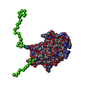+Search query
-Structure paper
| Title | The basic keratin 10-binding domain of the virulence-associated pneumococcal serine-rich protein PsrP adopts a novel MSCRAMM fold. |
|---|---|
| Journal, issue, pages | Open Biol, Vol. 4, Issue 1, Page 130090, Year 2014 |
| Publish date | Jan 15, 2014 |
 Authors Authors | Tim Schulte / Jonas Löfling / Cecilia Mikaelsson / Alexey Kikhney / Karina Hentrich / Aurora Diamante / Christine Ebel / Staffan Normark / Dmitri Svergun / Birgitta Henriques-Normark / Adnane Achour /  |
| PubMed Abstract | Streptococcus pneumoniae is a major human pathogen, and a leading cause of disease and death worldwide. Pneumococcal invasive disease is triggered by initial asymptomatic colonization of the human ...Streptococcus pneumoniae is a major human pathogen, and a leading cause of disease and death worldwide. Pneumococcal invasive disease is triggered by initial asymptomatic colonization of the human upper respiratory tract. The pneumococcal serine-rich repeat protein (PsrP) is a lung-specific virulence factor whose functional binding region (BR) binds to keratin-10 (KRT10) and promotes pneumococcal biofilm formation through self-oligomerization. We present the crystal structure of the KRT10-binding domain of PsrP (BR187-385) determined to 2.0 Å resolution. BR187-385 adopts a novel variant of the DEv-IgG fold, typical for microbial surface components recognizing adhesive matrix molecules adhesins, despite very low sequence identity. An extended β-sheet on one side of the compressed, two-sided barrel presents a basic groove that possibly binds to the acidic helical rod domain of KRT10. Our study also demonstrates the importance of the other side of the barrel, formed by extensive well-ordered loops and stabilized by short β-strands, for interaction with KRT10. |
 External links External links |  Open Biol / Open Biol /  PubMed:24430336 / PubMed:24430336 /  PubMed Central PubMed Central |
| Methods | SAS (X-ray synchrotron) / X-ray diffraction |
| Resolution | 2 - 2.25 Å |
| Structure data |  SASDAR3:  PDB-3zgh:  PDB-3zgi: |
| Chemicals |  ChemComp-ACT:  ChemComp-GOL:  ChemComp-EDO:  ChemComp-HOH:  ChemComp-SO4: |
| Source |
|
 Keywords Keywords | STRUCTURAL PROTEIN / MSCRAMM / KERATIN-10 / ADHESIN / SRRP |
 Movie
Movie Controller
Controller Structure viewers
Structure viewers About Yorodumi Papers
About Yorodumi Papers




